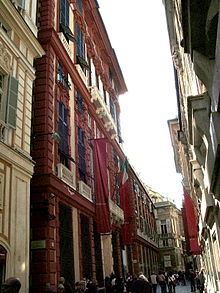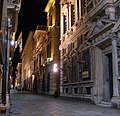History
The street, sanctioned in 1550, was built in 1558-1583. Originally named Strada Maggiore or Strada Nuova, in 1882 it was dedicated to Giuseppe Garibaldi. The street is 250 metres long and 7.5 metres wide.
Between the first half of the 16th century and the first half of the 17th century, the nobility of the Republic of Genoa started a careful town planning to transform the existing medieval city and initiate a sizeable urban expansion to the North. The move to expand the antique palaces and to build new sumptuous ones was driven by the extraordinary wealth that came into the city through prosperous financing activities towards several European powers. In particular, the Genoese aristocracy financed the expensive undertakings of the Spanish Crown, such as the mercenary army that Spain kept in Flanders from 1566 to the peace of Westphalia in 1648. The ruling class of Genoa, mixing nobility of blood with new mercantile wealth, sought to underpin their prestige by the construction of grand city palaces and suburban villas of unusual splendor. [2]
In literature
Charles Dickens gave a suggestive description of Strada Nuova in his travelogue Pictures from Italy. [3]
...When shall I forget the Streets of Palaces: the Strada Nuova and the Strada Balbi! or how the former looked one summer day, when I first saw it underneath the brightest and most intensely blue of summer skies: which its narrow perspective of immense mansions, reduced to a tapering and most precious strip of brightness, looking down upon the heavy shade below! The endless details of these rich Palaces: the walls of some of them, within, alive with masterpieces by Vandyke! The great, heavy, stone balconies, one above another, and tier over tier: with here and there, one larger than the rest, towering high up—a huge marble platform; the doorless vestibules, massively barred lower windows, immense public staircases, thick marble pillars, strong dungeon-like arches, and dreary, dreaming, echoing vaulted chambers: among which the eye wanders again, and again, and again, as every palace is succeeded by another- the terrace gardens between house and house, with green arches of the vine, and groves of orange-trees, and blushing oleander in full bloom, twenty, thirty, forty feet above the street—the painted halls, mouldering, and blotting, and rotting in the damp corners, and still shining out in beautiful colours and voluptuous designs...

Balbi may refer to:

Piazza De Ferrari is the main square of Genoa. Situated in the heart of the city between the historical and the modern center, Piazza De Ferrari is renowned for its fountain, which was restored in recent years along with a major restyling of the square.

The Palazzo Brignole Sale or Palazzo Rosso is a house museum located in Via Garibaldi, in the historical center of Genoa, in Northwestern Italy. The palace is part of the UNESCO World Heritage Site Genoa: Le Strade Nuove and the system of the Palazzi dei Rolli. The rich art collection inside, along with the galleries of Palazzo Bianco and Palazzo Doria Tursi, is part of the Musei di Strada Nuova and consists of the works of artists of the caliber of Antoon Van Dyck, Guido Reni, Paolo Veronese, Guercino, Gregorio De Ferrari, Albrecht Dürer, Bernardo Strozzi and Mattia Preti.

Genoa: Le Strade Nuove and the system of the Palazzi dei Rolli is a UNESCO World Heritage Site which includes a number of streets and palaces in the center of Genoa, in Northwestern Italy.
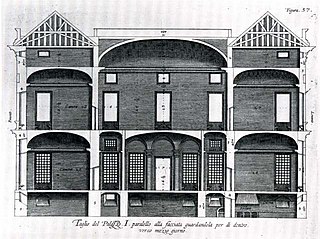
Palazzi di Genova is a 1622 book written and illustrated by Peter Paul Rubens, depicting and describing the palaces of Genoa, Italy in 72 plates. A second volume with 67 further plates was added the same year, and they are usually found together. The illustrations of the second part are usually considered not to be by Rubens though. It is the only book Rubens published himself.

Genoa is the capital of the Italian region of Liguria and the sixth-largest city in Italy. In 2015, 594,733 people lived within the city's administrative limits. As of the 2011 Italian census, the Province of Genoa, which in 2015 became the Metropolitan City of Genoa, had 855,834 resident persons. Over 1.5 million people live in the wider metropolitan area stretching along the Italian Riviera.
Palazzo Spinola or Spinola Palace may refer to:

The Palazzo Angelo Giovanni Spinola is a palace located in Via Garibaldi, in the historical center of Genoa, in Northwestern Italy. It was one of the 163 Palazzi dei Rolli of Genoa, the selected private residences where the notable guests of the Republic of Genoa were hosted during State visits. On 13 luglio del 2006 it was included in the list of 42 palaces which now form the UNESCO World Heritage Site Genoa: Le Strade Nuove and the system of the Palazzi dei Rolli. Now owned by a bank, it is possible to visit the areas open to the public.
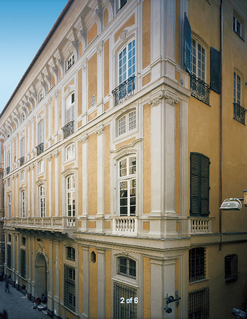
The Palazzo Doria or Palazzo Andrea e Gio. Batta Spinola is a palace located in Via Garibaldi, in the historical center of Genoa, in Northwestern Italy. It was one of the 163 Palazzi dei Rolli of Genoa, the selected private residences where the notable guests of the Republic of Genoa were hosted during State visits. On 13 luglio del 2006 it was included in the list of 42 palaces which now form the UNESCO World Heritage Site Genoa: Le Strade Nuove and the system of the Palazzi dei Rolli.
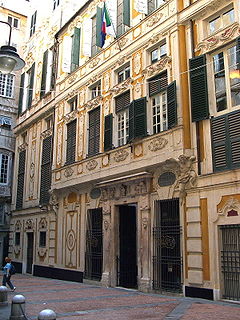
The Palazzo Spinola di Pellicceria, also known as Palazzo Francesco Grimaldi, is a palace located in piazza di Pellicceria in the historical center of Genoa, Northwestern Italy. The palace was one of the 163 Palazzi dei Rolli of Genoa, the selected private residences where the notable guests of the Republic of Genoa were hosted during State visits. On 13 luglio del 2006 it was added to the list of 42 palaces which now form the UNESCO World Heritage Site Genoa: Le Strade Nuove and the system of the Palazzi dei Rolli. It is currently owned by the Ministry of Cultural Heritage and Activities and Tourism and houses the National Gallery of Art in Palazzo Spinola.

Prè is a neighbourhood in the old town of the Italian city of Genoa. It was one of the six sestieri of ancient Genoa. At present it is part of the Genoa's city I Municipio. Located close to the old harbour, it is likely the best-known neighbourhood of the old town of Genoa.
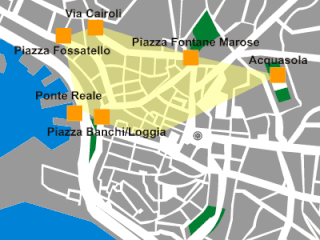
Maddalena is a neighbourhood in the old town of the Italian city of Genoa. It was one of the six sestieri of ancient Genoa. At present it is part of the Genoa's city Municipio I.

Villa Pallavicino delle Peschiere is a 16th-century villa in Genoa, Northwestern Italy, built in 1560 for the nobleman Tobia Pallavicino. It is situated in via San Bartolomeo degli Armeni 25, in the quarter of Castelletto, in an area that, at the time when the villa was built, was still outside of the city walls. After the urban expansion of the 19th century, it is now located in the center of the city. The villa still belongs to the Pallavicino family.
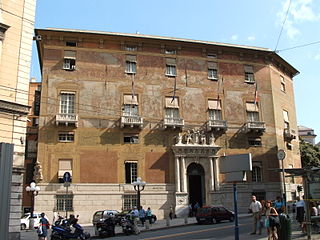
The Palazzo Doria-Spinola or Palazzo Antonio Doria is a palace located in largo Eros Lanfranco in the historical center of Genoa, Northwestern Italy. The palace was one of the 163 Palazzi dei Rolli of Genoa, one of those selected private residences where notable guests of the Republic of Genoa were hosted during State visits. On 13 luglio del 2006 it was added to the list of 42 palaces which now form the UNESCO World Heritage Site Genoa: Le Strade Nuove and the system of the Palazzi dei Rolli. The palace now hosts the Prefecture of Genoa and the seat of the Province of Genoa. It is possible to visit the areas of the building which are open to the public.
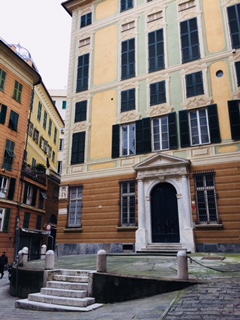
The Palazzo Clemente Della Rovere is a palace located in Piazza Rovere in the historical center of Genoa, Northwestern Italy. The palace was one of the 163 Palazzi dei Rolli of Genoa, the selected private residences where the notable guests of the Republic of Genoa were hosted during State visits. On 13 luglio 2006 it was added to the list of 42 palaces which now form the UNESCO World Heritage Site Genoa: Le Strade Nuove and the system of the Palazzi dei Rolli. The palace hosts today the General Consulate of Iceland.
Palazzo Doria may refer to a number of historical palaces and villas which belonged or still belong to the Doria family, originally De Auria, an old and extremely wealthy Genoese family who played a major role in the history of the Republic of Genoa and in Italy, from the 12th century to the 16th century.

Via Balbi is a street in the historical centre of Genoa, in Northwestern Italy, named after the aristocratic Genoese Balbi family. It is one of the Strade Nuove built by the Genoese aristocracy during the Renaissance. Since July 2006 it is inscribed in the list of UNESCO World Heritage Site Genoa: the Strade Nuove and the system of the Palazzi dei Rolli.

Via Cairoli is a street in the historical centre of Genoa, in North-western Italy, named after the 10th Prime Minister of Italy Benedetto Cairoli (1825-1889). Built in the 18th century as “Strada Nuovissima”, it is one of the Strade Nuove inscribed in July 2006 in the list of UNESCO World Heritage Site Genoa: the Strade Nuove and the system of the Palazzi dei Rolli.

The Strada Nuova Museums together form a single museum complex housed in the Palazzo Rosso, Palazzo Bianco and Palazzo Tursi, three of the Palazzo dei Rolli in Genoa, all located along the Via Garibaldi. The Palazzo Tursi also houses the city hall.
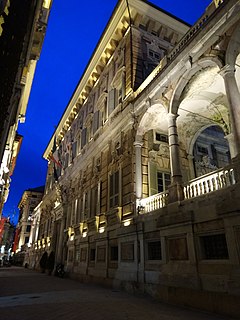
The palazzo Doria-Tursi or palazzo Niccolò Grimaldi is a building on Via Giuseppe Garibaldi in the historic town centre of Genoa. With Palazzo Rosso and Palazzo Bianco it houses the Strada Nuova Museums and on 13 July 2006 all three palaces and the streets around them became the Genoa: Le Strade Nuove and the system of the Palazzi dei Rolli World Heritage Site. Since 1848 Palazzo Doria-Tursi has also housed the city hall of Genoa.
